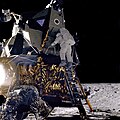List of Apollo astronauts

Most of the Apollo astronauts gathered at the Johnson Space Center in Houston in 1978. Names are included even for those not in the photo, with moonwalkers names in white and those who flew to the Moon without landing shown in dark grey. (Other names are shown in faint grey.)
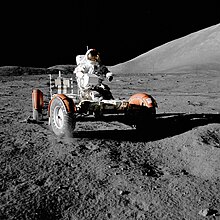
Eugene Cernan operating the Lunar Roving Vehicle during the Apollo 17 mission
Thirty-two astronauts were assigned to fly in the Apollo manned lunar landing program. Twenty-four of them, flying on nine different missions, reached an orbit around the Moon. (Of the other manned missions, Apollo 1 did not launch and Apollo 7 and Apollo 9 were low Earth orbit spacecraft testing missions). In addition, nine astronauts flew Apollo spacecraft in the Apollo Applications Programs Skylab and Apollo–Soyuz Test Project.
Twelve of these astronauts walked on the Moon's surface, and six of those drove Lunar Roving Vehicles on the Moon. While three astronauts flew to the Moon twice, of which two landed, none landed on the Moon more than once. The nine Apollo missions to the Moon occurred between December 1968 and December 1972.
Apart from these twenty-four men who visited the Moon, no human being has gone beyond low Earth orbit. They have, therefore, been farther from the Earth than anyone else. They are also the only people to have directly viewed the far side of the Moon. The twelve who walked on the Moon are the only people ever to have set foot on an astronomical object other than the Earth.
Of the twenty-four astronauts who flew to the Moon, two went on to command a Skylab mission, one commanded Apollo–Soyuz, one flew as commander for Approach and Landing Tests of the Space Shuttle, and two went on to command orbital Space Shuttle missions. A total of twenty-four NASA astronauts from the Apollo era flew on the Space Shuttle.
Contents
1 Prime crew members
1.1 From the Mercury Seven
1.2 From Astronaut Group 2
1.3 From Astronaut Group 3
1.4 From Astronaut Group 4
1.5 From Astronaut Group 5
2 Other astronauts who trained for Apollo but did not fly
3 Apollo astronauts who walked on the Moon
4 Apollo astronauts who flew to the Moon without landing
5 References
6 External links
Prime crew members
NASA's Director of Flight Crew Operations during the Gemini and Apollo programs was Donald K. "Deke" Slayton, one of the original Mercury Seven astronauts, who was medically grounded in September 1962 due to a minor cardiac arrythmia – paroxysmal atrial fibrillation. Slayton was responsible for making all Gemini and Apollo crew assignments. In March 1972, Slayton was restored to flight status, and flew on the 1975 Apollo–Soyuz Test Project mission.
The prime crew members selected for actual missions are here grouped by their NASA astronaut selection groups, and within each group in the order selected for flight. Two versions of the Apollo Command/Service Module (CSM) spacecraft were developed: Block I intended for preliminary low Earth orbit testing, and Block II which was designed for the lunar landing. The Block I crew position titles were Command Pilot, Senior Pilot (second seat), and Pilot (third seat). The corresponding Block II titles were: Commander, Command Module Pilot (second seat), and Lunar Module Pilot (third seat). The second seat pilot was given secondary responsibility for celestial navigation to keep the CSM's guidance computer accurately calibrated with the spacecraft's true position, and the third seat pilot served as a flight engineer, monitoring the health of the spacecraft systems.
From the Mercury Seven

(L to R) Scott Carpenter, L. Gordon Cooper, John Glenn, Grissom, Schirra, Shepard, and Slayton
Virgil I. "Gus" Grissom – Pilot of Liberty Bell 7 and commander of the first manned Gemini 3, Grissom was selected in 1966 as Command Pilot for the first manned mission, Apollo 1, a low Earth orbit test of the Block I Command/Service Module. This mission ended a month before its scheduled launch[1] when a cabin fire on the launch pad killed Grissom and his entire crew—Ed White and Roger Chaffee—on January 27, 1967. According to Slayton, Grissom would have been his choice to be the first to walk on the Moon.[2][3]
Walter M. Schirra Jr. – Pilot of Sigma 7 and commander of Gemini 6A, was selected to command a second CSM test flight which was canceled in late 1966, at which time he was reassigned as Grissom's backup. Twenty-one months after the Apollo 1 fire, Schirra commanded the first Block II CSM test flight, Apollo 7. He was the only member of the "Mercury Seven" to fly on all three programs.
Alan B. Shepard Jr. – America's first man in space on Freedom 7 was originally selected to command Gemini 3, but was medically grounded for the duration of Gemini due to Ménière's disease and assisted Slayton in Flight Operations. After corrective surgery, Shepard was restored to flight status and commanded Apollo 14, the third successful Moon landing mission.
From Astronaut Group 2
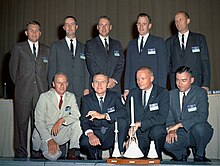
NASA Astronaut Group 2: Back row: Elliot M. See (died in Gemini training), McDivitt, Lovell, White, & Stafford. Front row: Conrad, Borman, Armstrong, & Young
All of these astronauts flew on Gemini, and except for White, each commanded one Gemini and one Apollo mission:
Ed White – Second-seat veteran of Gemini 4 who made the United States' first walk in space, selected as Senior Pilot (second seat) on Apollo 1. White was killed in the Apollo 1 fire along with Grissom and Chaffee.
James A. McDivitt – Commander of Gemini 4, selected in late 1966 to command the first Earth orbital flight test of the Apollo Lunar Module with the CSM. This mission flew in March 1969 as Apollo 9. After his flight, McDivitt was promoted to Manager of Lunar Landing Operations, and in August 1969 was promoted to Manager of the Apollo Spacecraft Program.
Frank F. Borman II – Commander of Gemini 7, selected to command a higher Earth orbit test of the complete Apollo spacecraft. But when delays prevented the LM from being ready in time for its first flight in December 1968, Borman's mission was changed to the first lunar orbital flight of the CSM on Apollo 8.
James A. Lovell Jr. – Second-seat veteran of Gemini 7, and commander of Gemini 12, flew as Command Module Pilot (second seat) on Apollo 8. Lovell became the first to fly a second Apollo mission as commander of Apollo 13, the third lunar landing attempt. This mission was unsuccessful, due to a Service Module electrical system failure caused by an oxygen tank explosion. Lovell and his crew managed to return to Earth safely.
Thomas P. Stafford – Second-seat veteran of Gemini 6A and commander of Gemini 9A, commanded a lunar orbital test of the Lunar Module on Apollo 10. He also commanded the Apollo–Soyuz Test Project mission.
John W. Young – Second-seat veteran of Gemini 3 and commander of Gemini 10, flew as Command Module Pilot on Apollo 10. Young later commanded the successful Apollo 16 lunar landing. He also commanded the first Space Shuttle flight, STS-1 Columbia, on April 12, 1981. He died January 5, 2018.
Neil A. Armstrong – Commander of Gemini 8, commanded Apollo 11, becoming the first man to set foot on the Moon.
Charles "Pete" Conrad Jr. – Second-seat veteran of Gemini 5 and commander of Gemini 11, commanded Apollo 12, the second lunar landing. He went on to command Skylab 2, successfully completing repairs to the spacecraft that saved it for this and two subsequent missions.
From Astronaut Group 3

NASA Astronaut Group 3
This was the first class of astronauts for which test pilot experience was not required, but military jet fighter pilot experience was acceptable.
Five of this group got their first spaceflight experience as second seat on Gemini:
David R. Scott – Second-seat veteran of Gemini 8, flew as Command Module Pilot on Apollo 9, and commanded the Apollo 15 lunar landing.
Eugene A. Cernan – Second-seat veteran on Gemini 9A, flew as Lunar Module Pilot on Apollo 10, and commanded the final lunar landing mission Apollo 17.
Michael Collins – Second-seat veteran on Gemini 10, flew as Command Module Pilot on Apollo 11.
Edwin E. "Buzz" Aldrin Jr. – Second-seat veteran on Gemini 12, flew as Lunar Module Pilot on Apollo 11, the first Moon landing.
Richard F. Gordon Jr. – Second-seat veteran on Gemini 11, flew as Command Module Pilot on Apollo 12. Gordon was selected to command the Apollo 18 lunar landing, which was later canceled.
The remaining six members of this group were selected for their first space flights on Apollo:
Roger B. Chaffee – Selected as Pilot (third seat) on Apollo 1, was killed with Grissom and White in the fire.
Donn F. Eisele – Flew second seat on Apollo 7.
R. Walter Cunningham – Flew third seat on Apollo 7.
Russell L. "Rusty" Schweickart – Flew as Lunar Module Pilot on Apollo 9. Schweickart performed an EVA outside the spacecraft, testing the portable life support system used on the Moon.
William A. Anders – Flew third seat on Apollo 8.
Alan L. Bean – Flew as Lunar Module Pilot on Apollo 12. He later served as Commander for Skylab 3.
From Astronaut Group 4

Harrison Schmitt (seated, center) became NASA's first scientist astronaut to fly in space.
In June 1965, NASA named a group of five scientist astronauts, the first group qualified by doctorate degrees rather than test or military fighter pilot experience.[4] Geologist Harrison H. "Jack" Schmitt participated heavily in the geological training of the lunar landing astronauts, as well as assisting in the analysis of returned samples and the preparation of mission reports. In 1970, he was selected as Lunar Module Pilot for the Apollo 15 backup crew, and prime crew on Apollo 18. When program cutbacks canceled missions 18 through 20, NASA's lunar geological community insisted on having a geologist on the Moon, so Slayton reassigned Schmitt to Apollo 17.
From Astronaut Group 5

NASA Astronaut Group 5
NASA named a group of 19 more astronauts in April 1966. None had spaceflight experience before their Apollo mission.
T. Kenneth Mattingly II – Selected as prime Command Module Pilot for Apollo 13, Mattingly was exposed to German measles days before the flight and was grounded by the flight surgeon, though ultimately did not contract the disease. He swapped places with his backup and flew on Apollo 16. He also flew on STS-4 and STS-51-C
John L. "Jack" Swigert Jr. – Flew as Mattingly's backup on Apollo 13.
Fred W. Haise Jr. – Flew as Lunar Module Pilot on the unsuccessful Apollo 13. Haise was selected to command the Apollo 19 lunar landing, which was canceled. Haise would later be named commander of the first crew for the Space Shuttle's Approach and Landing Tests using the prototype Space Shuttle Enterprise.
Stuart A. Roosa – Command Module Pilot on Apollo 14
Edgar D. Mitchell – Lunar Module Pilot on Apollo 14
Alfred M. Worden – Command Module Pilot on Apollo 15
James B. Irwin – Lunar Module Pilot on Apollo 15
Charles M. Duke Jr. – First achieved public recognition as capsule communicator during the Apollo 11 Moon landing; notable for the quote: "...we copy you on the ground. You've got a bunch of guys about to turn blue; we're breathing again. Thanks a lot."[5] Duke flew as Lunar Module Pilot on Apollo 16.
Ronald E. Evans Jr. – Command Module Pilot on Apollo 17.
Other astronauts who trained for Apollo but did not fly
L. Gordon Cooper Jr. – from the Mercury Seven; veteran of Mercury Faith 7 and commander of Gemini 5, was replaced as Apollo 14 commander by Alan Shepard and resigned from NASA in 1970.
Clifton C. Williams Jr. – from Group 3; was named as Schweickart's Lunar Module Pilot backup crew, but was killed when the T-38 jet he was flying crashed near Tallahassee, Florida on October 5, 1967. He was replaced by Bean, who flew on Apollo 12.
Edward G. Givens Jr. – from Group 5; was on the support crew of Apollo 7, but died in a car crash near Houston, Texas on June 6, 1967.
Joseph H. Engle – from Group 5; was originally named as Apollo 17 Lunar Module Pilot, but lost his slot to Schmitt. After Apollo, he flew in the Space Shuttle Approach and Landing Tests, then commanded STS-2 and STS-51I.
Apollo astronauts who walked on the Moon
Twelve people have walked on the Moon. Four of them are still living as of March 2019.[update] All manned lunar landings took place between July 1969 and December 1972 as part of the Apollo program. Most astronauts at that time came from the military services and were considered to be on active duty during their NASA service; the few exceptions were considered civilian NASA astronauts (regardless of any prior military service).
| Image | Name | Born | Died | Age at first step | Mission | Lunar EVA dates | Military service | Alma Mater | |
|---|---|---|---|---|---|---|---|---|---|
| 1 |  | Neil Armstrong | (1930-08-05)August 5, 1930 | August 25, 2012(2012-08-25) (aged 82) | 38y 11m 15d | Apollo 11 | July 21, 1969[6] | None[7] | Purdue University, University of Southern California |
| 2 |  | Buzz Aldrin | (1930-01-20) January 20, 1930 | 39y 6m 0d | Air Force | United States Military Academy, MIT | |||
| 3 |  | Pete Conrad | (1930-06-02)June 2, 1930 | July 8, 1999(1999-07-08) (aged 69) | 39y 5m 17d | Apollo 12 | November 19–20, 1969 | Navy | Princeton University |
| 4 |  | Alan Bean | (1932-03-15)March 15, 1932 | May 26, 2018(2018-05-26) (aged 86) | 37y 8m 4d | Navy | University of Texas, Austin | ||
| 5 |  | Alan Shepard | (1923-11-18)November 18, 1923 | July 21, 1998(1998-07-21) (aged 74) | 47y 2m 18d | Apollo 14 | February 5–6, 1971 | Navy | United States Naval Academy, Naval War College |
| 6 |  | Edgar Mitchell | (1930-09-17)September 17, 1930 | February 4, 2016(2016-02-04) (aged 85) | 40y 4m 19d | Navy | Carnegie Mellon University, Naval Postgraduate School, MIT | ||
| 7 |  | David Scott | (1932-06-06) June 6, 1932 | 39y 1m 25d | Apollo 15 | July 31 – August 2, 1971 | Air Force | University of Michigan, United States Military Academy, MIT | |
| 8 |  | James Irwin | (1930-03-17)March 17, 1930 | August 8, 1991(1991-08-08) (aged 61) | 41y 4m 14d | Air Force | United States Naval Academy, University of Michigan | ||
| 9 |  | John Young | (1930-09-24)September 24, 1930 | January 5, 2018(2018-01-05) (aged 87) | 41y 6m 28d | Apollo 16 | April 21–23, 1972 | Navy | Georgia Institute of Technology |
| 10 |  | Charles Duke | (1935-10-03) October 3, 1935 | 36y 6m 18d | Air Force | United States Naval Academy, MIT | |||
| 11 |  | Eugene Cernan | (1934-03-14)March 14, 1934 | January 16, 2017(2017-01-16) (aged 82) | 38y 9m 7d | Apollo 17 | December 11–14, 1972 | Navy | Purdue University, Naval Postgraduate School |
| 12 |  | Harrison Schmitt | (1935-07-03) July 3, 1935 | 37y 5m 8d | None[8] | Caltech, University of Oslo, Harvard University |
On each of the Apollo 17 extravehicular activities (EVAs), Harrison Schmitt was the second person out of, and the first person back into, the Apollo Lunar Module. Schmitt is thus the 12th and last person to have stepped onto the Moon. Eugene Cernan, as the second person to enter the lunar module on the final EVA, was the last person to have walked on the Moon.
Alan Shepard was the oldest person to walk on the Moon, at age 47 years and 80 days. Charlie Duke was the youngest, at age 36 years and 201 days.
Jim Lovell and Fred Haise were scheduled to walk on the Moon during the Apollo 13 mission, but the lunar landing was aborted following a major malfunction en route to the Moon. Haise was again scheduled to walk on the Moon as commander of Apollo 19, but Apollo 18 and Apollo 19 were canceled on September 2, 1970.
Joe Engle had trained on the backup crew for Apollo 14 to explore the Moon with Cernan, but Engle was replaced by Schmitt on the primary crew for Apollo 17. Schmitt had previously been crewed with Apollo 12 Command Module pilot Dick Gordon in anticipation of Apollo 18, but Schmitt replaced Engle on Apollo 17 after the cancellation of Apollo 18 and Apollo 19, leaving Gordon as the last Apollo astronaut to train extensively for lunar exploration without ever landing on the Moon.
Apollo astronauts who flew to the Moon without landing
Besides the 12 people who have walked on the Moon, 12 more have flown to within 0.001 lunar distance of its surface. During each of the six missions with successful lunar landings, one astronaut remained in lunar orbit while the other two landed. In addition, the three-person crews of Apollo 8 and Apollo 10 also entered lunar orbit, and the crew of Apollo 13 looped around the Moon on a free-return trajectory.
All nine manned missions to the Moon took place as part of the Apollo program over a period of just under four years, from 21 December 1968 to 19 December 1972. The 24 people who have flown to the Moon are the only people who have traveled beyond low Earth orbit. Twelve of them are still living As of March 2019[update].
Jim Lovell, John Young, and Eugene Cernan are the only three people to have flown to the Moon twice. Young and Cernan each set foot on it during their respective second lunar missions, while Lovell is the only person to have flown to the Moon twice without landing.
During Cernan's first lunar mission on Apollo 10, he tied the present record set by Bill Anders on Apollo 8 as the youngest person to fly to the Moon. Each was 35 years and 65 days old on his launch date and 35 years and 68 days old when he entered lunar orbit. The oldest person to fly to the Moon was Alan Shepard, who walked on its surface during the Apollo 14 mission. Shepard was 47 years and 74 days old on his launch date and 47 years and 78 days old when he entered lunar orbit.
Because of Apollo 13's free-return trajectory, Lovell, Jack Swigert and Fred Haise flew higher above the Moon's 180° meridian (opposite Earth) than anyone else has flown (254 km/158 mi). Coincidentally, due to the Moon's distance from Earth at the time, they simultaneously set the present record for humans' greatest distance from Earth, reaching an altitude of 400,171 km (248,655 mi) above sea level at 0:21 UTC on 15 April 1970.
| Image | Name | Born | Died | Age | Mission | Military service | Notes | |
|---|---|---|---|---|---|---|---|---|
| 1 |  | Frank Borman | (1928-03-14) March 14, 1928 | 40 | Apollo 8 December 21–27, 1968 | Air Force | ||
| 2 |  | Jim Lovell | (1928-03-25) March 25, 1928 | 40 | Navy | also flew on Apollo 13 | ||
| 3 |  | Bill Anders | (1933-10-17) October 17, 1933 | 35 | Air Force | |||
| 4 | 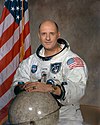 | Tom Stafford | (1930-09-17) September 17, 1930 | 38 | Apollo 10 May 18–26, 1969 | Air Force | later flew on Apollo–Soyuz Test Project | |
 | John Young | (1930-09-24)September 24, 1930 | January 5, 2018(2018-01-05) (aged 87) | 38 | Navy | landed on Apollo 16; later flew two Space Shuttle missions | ||
 | Eugene Cernan | (1934-03-14)March 14, 1934 | January 16, 2017(2017-01-16) (aged 82) | 35 | Navy | landed on Apollo 17 | ||
| 5 |  | Michael Collins | (1930-10-31) October 31, 1930 | 38 | Apollo 11 July 16–24, 1969 | Air Force | ||
| 6 |  | Dick Gordon | (1929-10-05)October 5, 1929 | November 6, 2017(2017-11-06) (aged 88) | 40 | Apollo 12 November 14–24, 1969 | Navy | trained to land, slated for Apollo 18 (canceled)[9] |
 | Jim Lovell | (1928-03-25) March 25, 1928 | 42 | Apollo 13 April 11–17, 1970 | Navy | already flown on Apollo 8; intended to land | ||
| 7 | 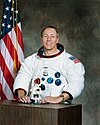 | Jack Swigert | (1931-08-30)August 30, 1931 | December 27, 1982(1982-12-27) (aged 51) | 38 | Air Force | ||
| 8 |  | Fred Haise | (1933-11-14) November 14, 1933 | 36 | Marines, Air Force | intended to land; later trained to land and slated for Apollo 19 (canceled);[9] flew the Space Shuttle on approach / landing tests | ||
| 9 |  | Stu Roosa | (1933-08-16)August 16, 1933 | December 12, 1994(1994-12-12) (aged 61) | 37 | Apollo 14 January 31 – February 9, 1971 | Air Force | in rotation to land on Apollo 20 (canceled) |
| 10 |  | Al Worden | (1932-02-07) February 7, 1932 | 39 | Apollo 15 July 26 – August 7, 1971 | Air Force | ||
| 11 | 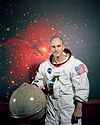 | Ken Mattingly | (1936-03-17) March 17, 1936 | 36 | Apollo 16 April 16–27, 1972 | Navy | later flew two Space Shuttle missions. | |
| 12 | 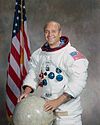 | Ron Evans | (1933-11-10)November 10, 1933 | April 7, 1990(1990-04-07) (aged 56) | 39 | Apollo 17 December 7–19, 1972 | Navy |
References
^ George E. Mueller, Associate Administrator of the Office of Manned Spaceflight, issued a directive on April 24, 1967, that the mission would be officially recorded as Apollo 1, "first manned Apollo Saturn flight - failed on ground test."
Ertel, Ivan D.; Newkirk, Roland W.; Brooks, Courtney G. (1978). "Vol.11, part 1 (1967 Mar/Apr), March 25 - April 24". NASA SP-4009: The Apollo Spacecraft – A Chronology. NASA. Retrieved March 3, 2011..mw-parser-output cite.citation{font-style:inherit}.mw-parser-output .citation q{quotes:"""""""'""'"}.mw-parser-output .citation .cs1-lock-free a{background:url("//upload.wikimedia.org/wikipedia/commons/thumb/6/65/Lock-green.svg/9px-Lock-green.svg.png")no-repeat;background-position:right .1em center}.mw-parser-output .citation .cs1-lock-limited a,.mw-parser-output .citation .cs1-lock-registration a{background:url("//upload.wikimedia.org/wikipedia/commons/thumb/d/d6/Lock-gray-alt-2.svg/9px-Lock-gray-alt-2.svg.png")no-repeat;background-position:right .1em center}.mw-parser-output .citation .cs1-lock-subscription a{background:url("//upload.wikimedia.org/wikipedia/commons/thumb/a/aa/Lock-red-alt-2.svg/9px-Lock-red-alt-2.svg.png")no-repeat;background-position:right .1em center}.mw-parser-output .cs1-subscription,.mw-parser-output .cs1-registration{color:#555}.mw-parser-output .cs1-subscription span,.mw-parser-output .cs1-registration span{border-bottom:1px dotted;cursor:help}.mw-parser-output .cs1-ws-icon a{background:url("//upload.wikimedia.org/wikipedia/commons/thumb/4/4c/Wikisource-logo.svg/12px-Wikisource-logo.svg.png")no-repeat;background-position:right .1em center}.mw-parser-output code.cs1-code{color:inherit;background:inherit;border:inherit;padding:inherit}.mw-parser-output .cs1-hidden-error{display:none;font-size:100%}.mw-parser-output .cs1-visible-error{font-size:100%}.mw-parser-output .cs1-maint{display:none;color:#33aa33;margin-left:0.3em}.mw-parser-output .cs1-subscription,.mw-parser-output .cs1-registration,.mw-parser-output .cs1-format{font-size:95%}.mw-parser-output .cs1-kern-left,.mw-parser-output .cs1-kern-wl-left{padding-left:0.2em}.mw-parser-output .cs1-kern-right,.mw-parser-output .cs1-kern-wl-right{padding-right:0.2em}
^ Zornio, Mary C. Detailed Biographies of Apollo I Crew - "Gus Grissom", NASA, accessed July 19, 2006.
^ Slayton, Donald K; Cassutt, Michael (1994). Deke!: U.S. Manned Space from Mercury to the Shuttle (1st ed.). New York City: Forge: St. Martin's Press. p. 234. ISBN 0-312-85503-6. LCCN 94-2463. OCLC 29845663.
^ Note: Edwin Aldrin and Eugene Cernan were selected for Group 3 without having been test pilots, though both were fighter pilots in the Air Force and Navy respectively.
^ "Footagevault, Project MOCR". Archived from the original on 2013-06-15.
^ This date is based on Coordinated Universal Time (UTC). Americans alive at the time remember it as the night of July 20, 1969 (Armstrong set foot on the Moon at 10:56 p.m. Eastern Daylight Time), but the official NASA chronology was kept in Greenwich Mean Time (GMT), so the first step was 2:56 a.m. on the 21st: [1]
^ Armstrong had mustered out of the United States Navy and was already a NASA employee when he and Elliot See became the first civilian astronauts in Astronaut Group 2; see Armstrong's NASA biography and a description of his receiving a NASA award, among others.
^ Schmitt, a geologist, was chosen as a scientist in Astronaut Group 4.
^ ab Williams, David R. "Apollo 18 through 20 - The Cancelled Missions". NASA.gov. Retrieved July 19, 2006.
External links
"Human Space Flight - Apollo History". NASA. January 30, 2004. Retrieved 2007-01-08.
One Giant Leap for Mankind: 35th Anniversary of Apollo 11, NASA, Michael Makara, accessed July 14, 2006



